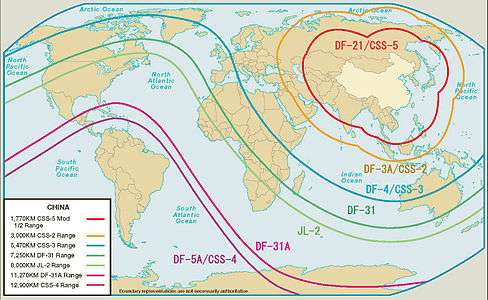DF-4
The Dong Feng 4 (Chinese: 东风-4; pinyin: Dōng Fēng Sì; lit.: 'East Wind 4') or DF-4 (also known as the CSS-3) is a first-generation two-stage Chinese intercontinental ballistic missile[7] with liquid fuel (Nitric acid/Unsymmetrical dimethylhydrazine). It was thought to be deployed in limited numbers in underground silos beginning in the late 1970s and early 1980s. The Dong Feng 4 has a takeoff thrust of 1,224.00 kN, a takeoff weight of 82000 kg, a diameter of 2.25 m, a length of 28.05 m and a fin span of 2.74 m. The range of the Dong Feng 4, which is equipped with a 2,190 kg nuclear warhead with 3.3 Megaton yield, with a nominal range of 5,500 km. This gives it sufficient range to strike targets as far away as Russia, India, and American bases in the Pacific.[8] The missile uses an inertial guidance system, resulting in a large CEP of 1,500 meters. As of 2017, 10-15 launchers are deployed.[9]
| DF-4/CSS-3 | |
|---|---|
 | |
| Type | ICBM |
| Place of origin | People's Republic of China |
| Service history | |
| In service | 1975/1976[1][2]–present |
| Used by | PRC |
| Production history | |
| Manufacturer | Factory 211 (Capital Astronautics Co.) |
| Unit cost | ? |
| Specifications | |
| Mass | 82,000 kg |
| Length | 28.05 m |
| Diameter | 2.25 m |
| Warhead | One,[1] or three (DF-4A)[3][4] |
| Blast yield | 3.3 Mt[1] |
| Engine | Liquid fueled |
Operational range | 5,500 km[5][6] |
| Maximum speed | ? |
Guidance system | Astro-inertial guidance |
History

The decision to develop the DF-4 was made in 1965[10] in response to the U.S. ballistic missile submarine patrols that began operating out of Guam. The missile's designer has been variously identified as Ren Xinmin or Tu Shou'e [屠守锷], and it was produced at Factory 211 (Capital Astronautics Co. [首都航天机械公司], also known as Capital Machine Shop [首都机械厂]).
In 1972 US intelligence estimated an IOC for this system as being expected in 1974 or 1975. Deployment actually began in 1975–76, but only four DF-4s were believed to be in place by 1984.[11]
There were two versions of the missile developed,[12] one version housed in caves or garages to be rolled out on launch and another silo based version.
The US DoD estimates that the missile will continue to serve as a regional deterrence instrument until they can be replaced by the DF-31.[13] This will be a significant capability gain for the Second Artillery Corps. The DF-31A has a range of 11,700 kilometers (as opposed to just 7,000 for the DF-4) and is road- and rail-mobile, and thus more survivable than the silo-based DF-4.[14]
Notes
- The Federation of American Scientists & The Natural Resources Defense Council Chinese Nuclear Forces and U.S. Nuclear War Planning p. 202
- PRC Defense Policy and Armed Forces, National Intelligence Estimate 13-76, November 11, 1976, p. 47.
- 中国东风系列导弹简介
- http://csatm.cn/f0309110006.html%5B%5D
- DF-4 - China Nuclear Forces
- DF-4 - China Nuclear Forces
- "东风4型洲际导弹 (Dongfeng VI intercontinental ballistic missile)". Archived from the original on 2009-09-15. Retrieved 2009-07-22.
- Diamond, Howard (July 1, 1999). "Chinese Strategic Plans Move Forward with Missile Test". Arms Control Today. Arms Control Association. ISSN 0196-125X. Retrieved August 22, 2015 – via Questia Online Library.
- Ballistic and Cruise Missile Threat (Report). Defense Intelligence Ballistic Missile Analysis Committee. June 2017. p. 29. NASIC-1031-0985-17. Retrieved 16 July 2017.
- U.S. Department of Defense, Office of the Secretary of Defense, The Military Power of the People’s Republic of China, 2005, 2005, p. 28
- "DF-4 - China Nuclear Forces". Fas.org. Retrieved 2010-03-21.
- U.S. Department of Defense, Office of the Secretary of Defense, The Military Power of the People’s Republic of China, 2000, 2000, p. 17.
- U.S. Department of Defense, Office of the Secretary of Defense, Military Power of the People’s Republic of China, 2006, May 22, 2006, p. 50.
- http://missilethreat.com/missiles/df-31-31a-css-9/?country=china#china Archived 2016-01-13 at the Wayback Machine
Operators

External links
- Astronautix
- https://web.archive.org/web/20121103103539/http://www.sinodefence.com/strategic/missile/df4.asp
- "DF-4 (CSS-3)". Missile Threat. Archived from the original on 2014-02-01.
| Preceded by DF-3 |
DF-4 | Succeeded by DF-5 |